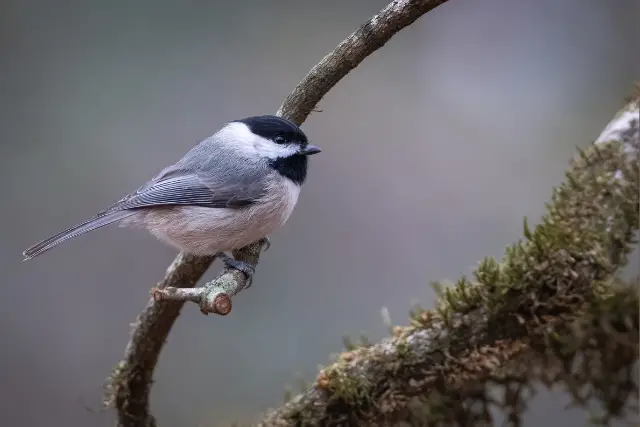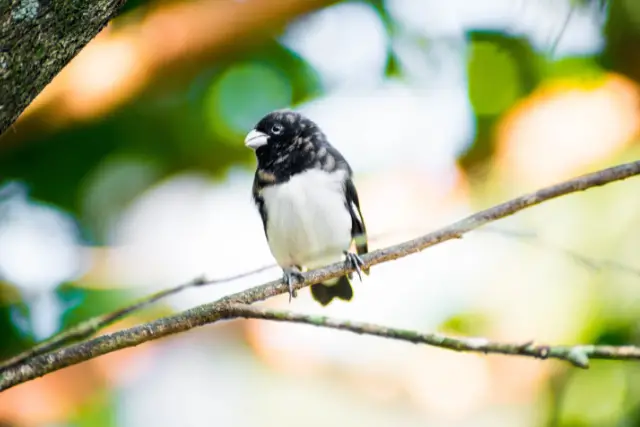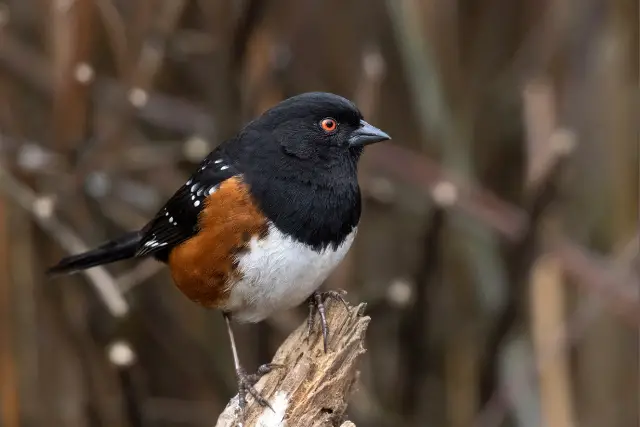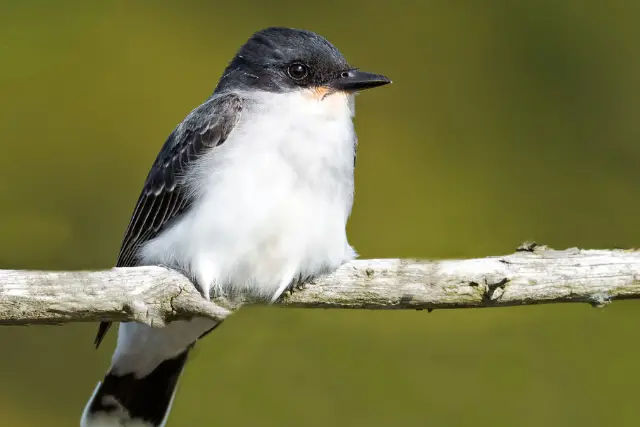Observing birds can be a serene and educational experience, especially when you encounter a small black bird with a white belly. This distinctive plumage is characteristic of several bird species that vary in their habits and environments.
Birdwatching can lead to many questions about the specific species you come across. You might wonder about their dietary preferences, breeding patterns, or how best to observe them without causing disturbance.
Let's dig deeper into that in this post!
Key Takeaways
- Small black birds with white bellies are identifiable by their unique plumage.
- Their habitats, diets, and behaviors are as diverse as the species themselves.
- Knowledge about these birds enhances birdwatching and aids in their conservation.
Different Species of Small Black Birds with White Belly

These birds, with their contrasting black and white colors, are often spotted in a range of habitats, from woodlands to urban areas, and understanding their behavior is key to appreciating their role in the ecosystem.
When you observe small black birds with white bellies, you're likely encountering one of several species. Their distinct markings can help in identification.
- Black-and-White Warbler: This warbler has a distinctive black and white striped pattern across its body, with a white belly that contrasts against black wings. Males often exhibit a black cap on their head.
- Black-capped Chickadee: Recognizable by its black head and neck, this small bird presents a white belly and cheeks. Despite its name, its back is more gray than black.
- White-throated Sparrow: It has a black-and-white striped head, a white throat, and a grayish belly. Its wings and back feature darker shades.
- European Starling: In its winter plumage, this bird displays white spots on its black feathers. Its belly tends to be lighter, and while not pure white, it can appear so at a distance.
- Eastern Kingbird: This bird has a black head, back, and tail, with a distinct white belly and throat. It exhibits sexual dimorphism, with males typically having more vivid colors.
- Spotted Towhee: Known for the distinctive white spots on its wings and back, the Spotted Towhee has a white belly, a black head, and a black neck.
Here's a quick reference for your observations:
| Species | Head | Belly | Wings | Notable Features |
|---|---|---|---|---|
| Black-and-White Warbler | Striped | White | Black with white | Black cap in males |
| Black-capped Chickadee | Black | White | Gray | White cheeks; black neck |
| White-throated Sparrow | Striped | Grayish | Dark | White throat; striped head |
| European Starling | Black | Lighter | Black with spots | Winter plumage; white spots |
| Eastern Kingbird | Black | White | Black | Assertive behavior; white throat |
| Spotted Towhee | Black | White | Black with spots | White spots on wings and back |
These species often inhabit gardens, woodlands, and fields, where you might spot them flitting about or hear their distinctive calls.
Habitats and Distribution

Understanding where you can find the small black bird with a white belly and the types of environments it thrives in is crucial for both birdwatchers and researchers.
Geographical Range
The black bird with a white belly can be found extensively throughout North America, ranging as far north as Alaska and throughout Canada, into the American Southwest, and as far south as Central America and parts of South America.
It has a significant presence in states such as California and Texas, as well as in Mexico. This species is quite adaptable, allowing for a broad geographical range.
- North America: Widespread, from northern regions of Alaska to Southern Canada.
- Central and South America: Presence noted, but sparser than in North America.
Preferred Habitats
Your search for this species would be most productive in various habitats ranging from boreal forests and coastal areas to forest edges and more open habitats. These birds are often found near water sources, which provide essential resources for their survival.
- Boreal Forests: Commonly found in the dense, coniferous woodlands of the north.
- Coastal Areas: Prefers the dynamic ecosystem where land meets the sea.
- Forest Edges and Open Habitats: Often spotted where the forest canopy opens up, allowing for mixed vegetation.
- Near Water Sources: Lakes, rivers, and wetlands are often within the bird's chosen habitats for easy access to water.
Diet and Foraging Behavior
Your understanding of a small black bird with a white belly is enriched by knowing what it eats and how it finds its food. The bird’s diet is diverse and their foraging behavior is adapted to their environment.
Feeding Habits
Your observation of these birds will reveal that they are opportunistic feeders. They tend to search for food both on the ground and in foliage. During their search, they use a combination of sight and sound to locate their prey.
They are not exclusive to any particular feeding location and are known to visit backyard feeders, especially if natural food sources are scarce.
- Ground Foraging: Typically scratches at the soil to uncover hidden seeds or insects.
- Foliage Foraging: Can be seen hopping from branch to branch pecking at fruits or catching bugs.
- Backyard Feeders: Prefer feeders with a variety of seed mixes and may compete with other birds for access.
Typical Diet
Your knowledge of this bird includes an understanding that their diet is mainly composed of:
- Insects: A significant part of their nutrition, especially in spring and summer. These include:
- Beetles
- Ants
- Spiders
- Berries: Consumed when abundant; common in the bird's diet during certain seasons.
- Seeds: A staple in their diet year-round, often sourced from:
- Grasses
- Shrubs
- Backyard feeders when natural seeds are less available
They adjust their dietary intake according to seasonal availability, with seeds being more prominent during colder months when insects are not as readily accessible.
Breeding and Lifecycle
In observing the breeding and lifecycle of the small black bird with a white belly, you will find distinct mating patterns and nesting habits that are essential for the survival of the species.
Mating Patterns
During the breeding season, which typically spans from early spring to late summer, you will notice that these birds often engage in intricate courtship displays.
Males can be seen performing aerial acrobatics, singing complex melodies, or bringing offerings to entice potential mates. The species is generally monogamous, with pairs forming strong bonds that can last multiple breeding seasons.
| Breeding Season | Courtship Behavior | Monogamy Status |
|---|---|---|
| Early Spring - Late Summer | Aerial acrobatics, singing, offerings | Often monogamous |
Nesting
Once mated, the pair focuses on constructing a secure and comfortable nest. The preferred nesting sites typically include tree cavities, dense shrubs, or even man-made structures, provided they offer adequate protection.
Material selection for the nests involves twigs, grass, and feathers, carefully woven to support the eggs and future chicks.
- Nesting Sites: Tree cavities, dense shrubs, man-made structures
- Material Used: Twigs, grass, feathers
- Purpose: To support eggs and protect chicks
The female is responsible for laying a clutch of eggs, usually ranging from 3 to 6 in number. These eggs are characterized by their pale color with speckles and are incubated by the female for about two weeks.
During this period, the male may take on the role of protector and provider until the eggs hatch and the chicks begin their lifecycle.
- Egg Clutch Size: 3 to 6 eggs
- Egg Description: Pale-colored with speckles
- Incubation Period: ~2 weeks
Throughout the lifecycle of these birds, from egg to fledgling, and eventually to adulthood, your understanding of their breeding patterns and nesting habits provides insight into the mechanisms that ensure the continuity of the species.
Conservation and Observation
When you observe small black birds with white bellies, you're likely encountering a species with a stable conservation status. These are considered common and adaptable members of the avian world, contributing to ecosystem diversity.
To ensure their conservation, familiarize yourself with their habitat requirements and participate in local conservation efforts.
When engaging in birdwatching, you play a crucial role in conservation. Your ability to identify this bird's distinctive features helps contribute to citizen science initiatives and assists in monitoring bird populations. Keep this checklist in mind:
- Distinctive Features: Look for a crisp white belly that contrasts with its black plumage.
- Behavior Patterns: Observe their feeding habits and interactions with other bird species.
| Activity | Tips for Birdwatchers |
|---|---|
| Identification | Use a field guide to confirm species. |
| Ecosystem Impact | Note the bird's role in the local habitat. |
| Reporting Sightings | Share observations with conservation groups. |
Birdwatchers and birders alike can contribute to preserving the diversity of bird populations by reporting sightings to conservation bodies. If you're new to birdwatching, understand that your contributions are valuable.
Even common species need monitoring, as environmental changes can quickly alter their status.
Your knowledge and observations support scientists and conservationists in their efforts to maintain healthy bird populations. Engage with local organizations and join birding communities to stay informed about conservation actions you can participate in.
Remember: Your participation in birdwatching not only brings you closer to nature but also assists in the global efforts to conserve our precious wildlife.
Frequently Asked Questions

Discover the subtleties of identifying small black birds with white bellies through these targeted questions.
What small black bird species with white belly are rarely seen?
You might encounter the Black-bellied Seedeater, which is native to South America and quite rare. Additionally, the White-bellied Cuckooshrike is not commonly seen as it tends to reside in dense forests in Australia and New Guinea.
How can I identify a bird that is black with a white chest?
To identify a black bird with a white chest, observe its size, beak shape, tail length, and behavior. For instance, the White-bellied Go-away-bird displays a distinctive long tail and crest on its head, while the Rose-breasted Grosbeak features a thick beak suitable for seed-eating.
What bird looks like a crow and has a white belly?
The Black-billed Magpie may resemble a crow due to its black plumage but can be distinguished by its white belly and long, iridescent tail. Although similar in size to crows, their distinct color pattern and longer tail feathers set them apart.

